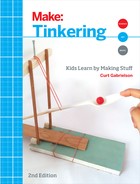B Evaluation Questionnaire for Students
We often give evaluation (eval) questionnaires to older students after class group sessions. We believe they help students think back over what they’ve just done and learned. Ideally, they also get practice writing and using new vocabulary. In our experience, few are truly interested in this sort of introspection and reanalysis, and many just want to continue tinkering until (a) the period is over or (b) we coerce them to sit down and do it (You’re not taking your project home until you finish your eval!). There has rarely been a time when we’ve got kids in the free-form tinkering sessions to sit down and do this. I think the internal urge to self-evaluate must come with a bit of age.
We sometimes present the eval in the form of a journal that kids add to each week, and sometimes in the form of a paper we copy off and hand out. It also works just to write the prompts on the board and have kids write responses on their own paper. The eval often has four parts, and we encourage the students to focus on whichever part is the most interesting or useful for them.
“Draw your project.” This is important for kids who have trouble writing, and for visual/special kids.
“What were the main steps you used in constructing your project?” Ideally this gets the kids to think back about the process they used to learn how to do the project, but be forewarned that many kids are well content to remain ignorant about this. If they can focus, it is a good exercise just to write the trivial: cut the board, glued the dowel, attached the string, etc.
“What did you learn by making your project?” The biggie. More on this below.
Content Questions. These are like those in this book’s project sections under Check It Out. They are questions designed to be answerable by means of playing around with the project, as opposed to quiz-type questions (What are the three states of matter?).
Question 3 seems straightforward; that’s what we all want to know, right? Unfortunately the answers given rarely satisfy: “A lot.” “More than I ever imagined.” “Nothing.”
In recent years, we’ve tweaked and kneaded that question to result in better answers. We then rotate through these prompts:
• Here is advice I would give to someone else who wants to build this project:
• This is the part of this project that I had trouble making and how I solved the problem:
• Something I would like to understand better about this project is:
• Some ways the project I built is different from the real-life version are:
• The part of this project that worked very well for me was:
• One thing I would do differently to improve this project if I did it again is:
• This project is related to science and engineering because:
